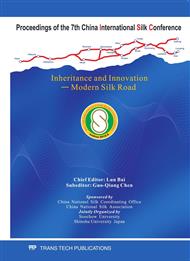p.181
p.186
p.192
p.197
p.202
p.209
p.214
p.220
p.224
Structure and Properties of Bombyx Mori Silk Fiber Modified by Extract of Cactus
Abstract:
The cactus is a kind of abundant foliage used for the Chinese medicine, which has special physical-chemistry properties and physiological function. It has been utilized for various fields. The B. mori silk fiber was slightly dissolved with CaCl2-EtOH-H2O solution and subsequently treated with the cactus extracts solution in aqueous acetic acid. The weight gain of the slightly dissolved B. mori silk fiber after cactus extracts modification was much higher than that of original silk fiber, and it increased remarkably with the CaCl2-EtOH-H2O dissolution time and cactus extracts concentration increasing. Scanning electron microscopic photographs showed that the microvoids appeared inside the slightly dissolved silk fiber and the fiber surface was changed after the series reaction with cactus extracts. Infrared spectra of the modified silk fiber suggested that the conformation of fibroin molecules had a trend to β sheets. The crystallinity of the modified silk fiber did not change remarkably by the X-ray diffraction analysis. Furthermore, with the cactus extracts treatment, the mechanical strength and elongation of silk fiber decreased slightly, whereas the initial modulus and elastic deformation of the silk fiber enhanced. Meanwhile, the cactus extracts modified B. mori silk fiber possessed a good antibacterial property.
Info:
Periodical:
Pages:
202-208
Citation:
Online since:
January 2011
Authors:
Keywords:
Price:
Сopyright:
© 2011 Trans Tech Publications Ltd. All Rights Reserved
Share:
Citation:


